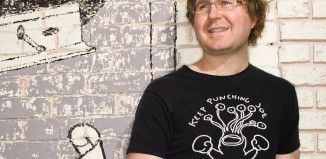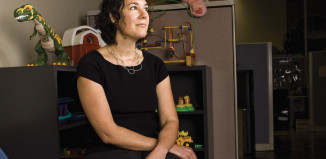Look closely at one of Marcus Sanchez’s paintings—an ethereal owl in skeletal form perched on a branch, with a bright red heart and yellow beak, two pink roses for eyes, set against a black background—and you are drawn in. You notice the lush, rich colors and the juxtaposition of playful and dark impulses. Dia de los Muertos, or Day of the Dead, the Mexican holiday that honors those who have died, might come to mind. That uncertainty, not knowing exactly what the artist’s intentions were with this particular work, is what fuels your appreciation of it.
“I like watching people have their opinions and trying to figure things out,” said Sanchez. “I want my art to speak to people. I prefer to bring creativity to everything I do—it could even be with marketing materials at work.”
Sanchez, who grew up near the Gulf Coast in the small town of Palacios and began to draw at an early age pictures of his grandfather’s World War II army tattoos, spends his days as the communications coordinator for AIDS Services of Austin, while his nights (and weekends) are typically consumed with painting and making art in his work space at home.
Around the age of 10, he got into comic books like Spider-Man and Spawn, drawing the superhero characters, but it wasn’t until junior high and high school, when two art teachers took Sanchez under their wings, that his creativity was fully sparked and encouraged. Although the schools he attended did not have large art programs, these two women, Miss Savage and Miss Beck, each offered him private lessons, shared art supplies, and pushed him to enter his artwork into one of the University Interscholastic League art competitions.
He medaled in the UIL event, was Miss Beck’s student aide, and reveled in being allowed to spend time in a musty old teachers’ lounge in the school (it reeked of cigarette smoke from the 1980s, he added), with only his paint, easel and brushes, to pursue his interest beyond whatever lessons were being taught in class. His parents recognized his budding talent and encouraged him; his blossoming creativity differed from the typical expectations of what boys will pursue (read: sports), Sanchez explained.
Although he’s developed a folk art style that draws on Mexican and Catholic cultural and religious traditions in his Loteria series, and his kitchen is decked out in Catholic art—a mold plate of the Last Supper, Virgin Mary plates and crucifixes dot the walls—Sanchez said that many people are surprised to learn two facts about his upbringing: He grew up Presbyterian, not Catholic, and he did not speak Spanish growing up.
Value Family
Loteria is a Mexican game of chance similar to bingo that uses unique images on a deck of cards instead of numbers on ping-pong balls. Sanchez’s grandmother, Teresa, grew up with it, and even as she got older and was in an assisted living center, she played more often with friends, inviting him to join in as well. Around the holidays, the entire family would play; for his grandmother, who called him Marcitos or “little Marcus,” it was a meaningful tradition
that she wanted to hand down. “I sat and played with them a few times, but it was pretty cutthroat,” he said, adding with a laugh that his grandmother and her friends bet with the money from their social security checks. “After she passed away, we found a letter she’d written, where she said she wanted us to keep getting together and playing Loteria as a family.”
Sanchez’s Loteria paintings, though reflective of older Mexican cultural traditions, maintain a modern and whimsical feel through the use of bright colors, the addition of details like cowboy boots and the way that he adds storytelling elements to each of the skulls. “The last two years, it’s been healing for me to embrace that side (of my art),” he said. “It’s kept me motivated and passionate.”
“His unique style is influenced by living on the south Texas coast,” said Lew Aldridge, founder of the Octopus Club. “It’s colorful, zany and most of all, fun.”
Working a lot with acrylics, which dry fast, is something Sanchez enjoys. He moves quickly as a painter, but does not rule out the use of oils for projects that are more detailed or realistic. Like any working artist, he works better in certain environments than others: If you visit his home studio, you’ll see easels, art desks, drafting and light tables. Rather than requiring quiet, Sanchez enjoys the white noise of old horror movies, teen flicks or cheesy romantic comedies. “I spread out—on the floor or on the table,” said Sanchez, a 15-year resident of Austin. “If I paint more than six to eight hours, I have to take a break and get away. I’ll usually paint in two-to- three-hour increments.”
 “What impresses me the most about his work as a painter is the ease and how effortlessly his talent and creativity seem to translate onto the canvas,” said Mark Evaro, a friend who has known Sanchez for a decade. “Having the rare opportunity to watch him at work on a couple of occasions, it truly made me take a step back and say, ‘Wow, this guy is really talented.’”
“What impresses me the most about his work as a painter is the ease and how effortlessly his talent and creativity seem to translate onto the canvas,” said Mark Evaro, a friend who has known Sanchez for a decade. “Having the rare opportunity to watch him at work on a couple of occasions, it truly made me take a step back and say, ‘Wow, this guy is really talented.’”
Because of his parents’ work schedules—his father, Andrew, worked long hours in construction and his mother, Elizabeth, went back to school for her nursing degree—Sanchez frequently stayed at his grandparents’ house, spending time watching old Westerns, listening to Hank Williams records with his grandfather and watching The Golden Girls on TV with his grandmother.
Although Sanchez said he was always aware of his sexuality as a gay man, growing up in a small town prevented him from feeling comfortable enough to come out before his early twenties and precluded any early exposure to LGBT culture or peers. But his family’s devout Presbyterian upbringing did not have the impact one might expect. “I never got a bad feeling or taste in my mouth around religion because it was never taught in a negative way. It was about the way my grandmother lived her life,” he said, adding that she passed away three years ago. “She was the most nonjudgmental woman I ever met.”
After a brief detour into what Sanchez termed “Lifetime movie territory—asking if she made me this way”—his mother, along with his father, came to accept their son and said that they just want him to be happy. One of his sister’s best friends growing up was transgender, and his mother was always accepting, so she was well-versed in this area.
Shortly after graduating from high school, he moved to Austin to seek creative fulfillment and took courses in the Visual Communications program at Austin Community College. Sanchez added that he believes Austin is generally supportive of its artistic community. Personally, he attends art shows at local galleries and museums such as AMOA-Arthouse, Grey Duck Gallery and Mexi-Carte to spark his creative juices and find inspiration.
Eradicate Stigma
“My grandmother instilled in my life to always help others. She taught me that as long as I was breathing, there would always be those less fortunate, and I should always do what I can to help them. I like to talk to people and have open conversations and really talk about things,” said Sanchez. “I think talking about experiences can help someone else.”
In 2006, Sanchez was meeting people and socializing in the community by attending nonprofit events such as Art Erotica, an annual fundraiser that benefits ASA’s Paul Kirby Emergency Fund, which has been providing emergency financial assistance to Central Texans living with HIV and AIDS since 1989. For the next few years, he donated art for the event’s silent auction and started getting involved with the planning of Octopus Club events as well. Two years after he began to donate his artwork, Sanchez lost a good friend to AIDS. This particular friend, Philip, had lived with the disease for 10 years and was seemingly healthy. The majority of his friends, including Sanchez, and his family never knew about Philip’s status—until his life’s circumstances brought it into stark relief. Stressed from having to take care of his ailing mother and deal with some financial issues, Philip got sick and caught pneumonia,never truly recovering.
“It was a shock to everyone and it happened so fast; it hit me hard because I felt like I could’ve been doing more,” said Sanchez. “There was a whole side of him I didn’t know about because he kept it to himself. I had a greater appreciation for the emergency situation where the Paul Kirby Fund kicks in and the peace of mind and stress management it gives clients.”
For OctoTea 13, the group was looking for a graphic designer and he met with Michelle Patterson, who was working a head octopus at the time. For each subsequent OctoTea and Art Erotica, he was on the planning committee. This is his second and final year of being a head octopus—which is the Octopus Club’s name for its rotating set of leaders—and there are a total of four people serving two-year terms.
“His heart is bigger than his largest canvas. I think his greatest asset as an activist is his inclusiveness,” said Aldridge, a partner of Alori Properties and longtime nonprofit leader. “He is a master of outreach and can recruit anyone to his causes.”
In his current full-time role at AIDS Services of Austin, he handles the nonprofit’s social media, manages marketing strategies, and oversees the revamp of its website in coordination with ASA’s 25th anniversary. “At the end of the day, I remind myself that it’s the people we serve who need this money we work to raise. I consider myself blessed to be a part of that process.”
“I was so pleased when I heard he joined the ASA team. He is a very special person, with a huge heart and a strong work ethic,” said Patterson. “I am so proud that our relationship led him to a wonderful opportunity! They’re lucky to have him on board.”
After his friend passed away, Sanchez and several of Philip’s other friends participated in the Hill Country Ride for AIDS. His death also drove home another of Sanchez’s passions: addressing stigma around HIV and AIDS and ultimately demystifying the disease for everyone. The stigma is another reason why people are still dying, he emphasized. Since people are afraid to get tested, if they are HIV positive they might get sick before even knowing their status.
“I see a younger generation of gay and queer men who aren’t really affected by it—and yes, we hear about all the good things and what HIV medication can do, but not everyone is fortunate enough to be able to afford that lifestyle, so there’s that whole side,” he said, adding that ASA is seeing younger clients, who don’t have the money or health insurance to take care of themselves, more often.
Ignorance about HIV and AIDS, both within the LGBT community and outside of it, troubles Sanchez. There’s also the deafening silence that results from the stigma associated with the disease. Not long ago, Sanchez was approached by a woman who had lost her brother in the 1980s to the illness; pouring her heart out to him, she started to cry.
The following week, Sanchez received a card in the mail. “She said how amazing it was to have that conversation because she hadn’t talked about it in 15 years because it just wasn’t something you talked about and she wasn’t around people who she could talk to. Since it’s still stigmatized and taboo, having that short conversation really impacted her. It makes me feel validated because I know that on some level, I’m helping someone with what I do. I felt good about just being there for her and just talking to her.”
Ranging from the sublime to the thought-provoking with unique or surprising touches of humor, Sanchez’s work is likely to prompt a wide range of responses. For instance, one painting depicts a skeleton with a bright sacred heart carrying the Earth on its back (Mexico is shaded a deep red against the arid brown of the rest of the continent)—while wearing a pair of pink underwear. On the other end of the spectrum, his sweet portraits of cats and dogs are realistic and very warm.
For a long time, as he began his career as a painter, Sanchez was reluctant to sell his work. He held on to many pieces or, at times, gave them away. At the time of the interview in early June, he was in the midst of putting together several projects and hoping to dive into working more with oils, a medium he hasn’t explored as much as acrylics.
First, he’s framing all of his work, so his overarching goal is to sell some pieces in order to fund that effort. As part of an exhibit coinciding with the anniversary of the AIDS Walk, Sanchez’s artwork will be displayed in Bouldin Creek Coffee House. He also wants to put on a group show with a few other Latino artists in the LGBT community in November, perhaps around the Day of the Dead. He also began a Michael Jackson piece, wherein the skull of the deceased King of Pop will be painted in different images—and he’ll also be outlined in a surprising way.
“I don’t mind being known for several different styles,” said Sanchez. “This Loteria series, it’s been therapeutic with the loss of my grandmother, and it’s been helpful in ways I might not fully understand now. I’ll move on to something totally different next.”
His grandmother would certainly be proud.




































